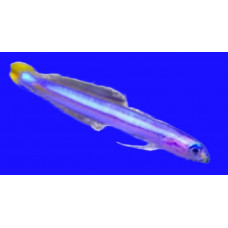Latin name
Ptereleotris uroditaenia
Other name
Bandtail Dartfish, flag-tail dart-goby.
Identification
The flagtail dartfish has 26 vertebrae. Chin with median longitudinal fold. Scales small, densely packed, not fused except posteriorly on caudal peduncle.
Features of fish fins
Dorsal spines (total): 7; Dorsal soft rays (total): 26; Anal spines: 1; Anal soft rays: 24.
1st dorsal fin higher than 2nd; rays from 3rd to 5th spines very long and filiform.
Fish colouring
When alive, Flagtail Dartfish are pale bluish in color. There are bright markings on the head. Named uroditaenia (Greek) because of two dark stripes on the caudal fin.
Distribution
Widespread in the western central Pacific from Indonesia to the Solomon Islands and Australia.
Habitat
A tropical marine species associated with reefs. Habitat depths range from 18 to 40 m.
Size
The maximum length of males of this species is 10.0 cm.
Behavior
They inhabit sheltered sandy and rubble bottoms, solitary or in small groups, usually away from reefs at moderate depths.
Food and feeding habits
Flagtail dartfish feed exclusively on plankton.
Reproduction
In their natural habitat, these fish mate and become the parents of juvenile fish. No successful breeding has been reported in captivity.
Fishing
This species is commercially important for fishing.
Relationship with a person
Harmless. This species is very popular in the aquarium hobby.
| Classification | |
| Phylum | Chordata |
| Class | Actinopterygii |
| Squad | Perciformes |
| Family | Microdesmidae |
| Genus | Ptereleotris |
| Species | P. uroditaenia |
| Features | |
| Conservation status | Least Concern |
| Habitat | Pelagic |
| Life span, years | No information |
| Maximum body weight, kg | No information |
| Maximum length, cm | 10 |
| Sailing speed, m/s | No information |
| Threat to people | Edible |
| Way of eating | Planktonophage |
Flagtail dartfish
Tags: flagtail dartfish

